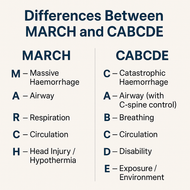Understanding the Differences Between MARCH and CABCDE in Trauma Care
Posted by DS Medical on 6th Nov 2025
In pre-hospital and tactical medicine, structured assessment frameworks are vital for delivering effective, prioritised patient care. Two of the most widely used trauma assessment methods are MARCH and CABCDE. While both are designed to help clinicians, first responders, and medics identify and treat life-threatening conditions quickly, they are tailored to slightly different environments and operational needs.
This article explores the key differences, applications, and benefits of each approach.
What Is MARCH?
MARCH is a mnemonic used primarily in tactical combat casualty care (TCCC) and hostile or austere environments. It focuses on the immediate management of life-threatening injuries that could rapidly lead to death if not addressed in the right order.
MARCH stands for:
- M – Massive Haemorrhage: Control catastrophic bleeding first using tourniquets, haemostatic dressings, or pressure bandages.
- A – Airway: Ensure a patent airway; consider recovery position, airway adjuncts, or surgical airway if needed.
- R – Respiration: Assess and manage breathing problems such as open chest wounds or tension pneumothorax.
- C – Circulation: Check for signs of shock, internal bleeding, and maintain perfusion.
- H – Head Injury / Hypothermia: Manage traumatic brain injury and prevent heat loss to reduce the risk of hypothermic shock.
MARCH is rapid, focused, and tactical—it’s designed for use in high-threat or resource-limited settings, such as military operations, remote rescue, or mass-casualty incidents.
What Is CABCDE?
CABCDE is a structured trauma assessment approach widely used in civilian emergency medicine and prehospital care. It aligns with the Advanced Trauma Life Support (ATLS) and Pre-Hospital Trauma Life Support (PHTLS) guidelines.
CABCDE stands for:
- C – Catastrophic Haemorrhage: Control major bleeding immediately, often considered before airway in modern practice.
- A – Airway (with C-spine control): Ensure the airway is clear while protecting the cervical spine.
- B – Breathing: Assess breathing rate, depth, symmetry, and oxygenation.
- C – Circulation: Evaluate pulses, perfusion, and signs of shock; manage internal and external bleeding.
- D – Disability: Assess neurological status using AVPU or GCS.
- E – Exposure / Environment: Fully expose the patient to assess for hidden injuries and prevent hypothermia.
CABCDE provides a comprehensive and systematic approach suitable for both trauma and medical emergencies in the civilian sector.
Key Differences Between MARCH and CABCDE
|
Aspect |
MARCH |
CABCDE |
|
Origin |
Tactical Combat Casualty Care (TCCC) |
Civilian Prehospital / ATLS Framework |
|
Primary Focus |
Rapid management under threat (combat or tactical scenarios) |
Comprehensive assessment in controlled environments |
|
Sequence Priority |
Life-threatening bleeding first |
Structured with spinal protection and full patient evaluation |
|
Environment |
Hostile, remote, or battlefield conditions |
Civilian and clinical emergency settings |
|
Assessment Depth |
Focused on survival priorities |
Broader patient assessment and ongoing care |
When to Use Each
- MARCH is ideal for tactical medics, military personnel, search and rescue teams, and remote responders—any situation where treatment must be performed quickly, often before full evacuation is possible.
- CABCDE is suited to paramedics, emergency medical technicians (EMTs), and hospital-based clinicians, where resources and personnel allow for more comprehensive assessment and stabilisation.
Conclusion
Both MARCH and CABCDE share the same goal: saving lives through structured, prioritised trauma management. The key difference lies in their context and depth. MARCH is built for speed and survivability in high-risk environments, while CABCDE ensures thorough, systematic care in prehospital and clinical settings.
Understanding when—and how—to apply each framework ensures patients receive the right care, at the right time, in the right order.


